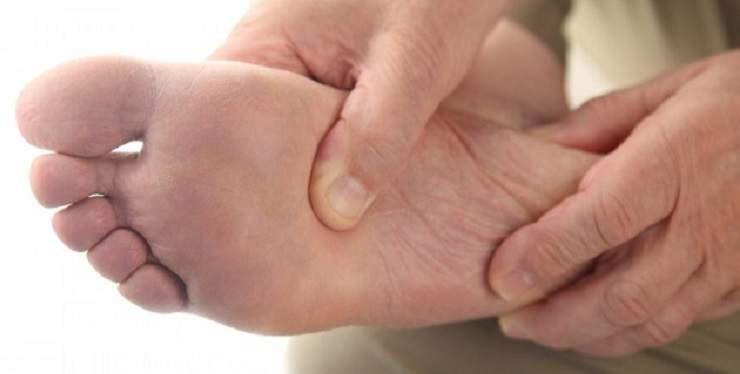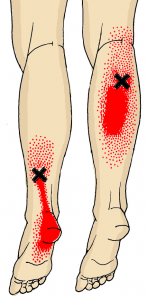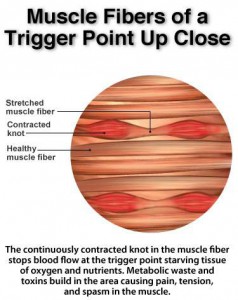
If you search for information about deep tissue massage and plantar fasciitis, you’ll probably be both thrilled and frustrated. The thrill will come from the fact that there are innumerable articles and videos related to the topic. Your frustration could be a result of not being able to discern between the techniques and recommendations as to which one(s), if any, might be best.
You will find a number of terms that seem to be related to this type of massage. To go with deep tissue massage, some of the terms you might find most prevalent are “rolfing”, “myofascial release” or “myofascial massage”, and “trigger point release” or “trigger point therapy”.
As I researched deep tissue massage, I came to realize that these various terms are often mixed together. Several of the terms related to techniques that could be included as part of deep tissue massage. That is where this article will begin.
Deep Tissue Massage Therapy
One of the best descriptions of deep tissue massage that I found is in the article “Deep Tissue” Massage Defined, written by Chena Talkington. The author noted that the term “deep tissue massage” has been overused, and commonly misused, by therapists.
During deep tissue massage a therapist will concentrate for a period of time, such as 15-20 minutes, to work in between certain muscle tissue fibers. In fact, many argue that deep tissue massage resembles physical therapy more than massage.
Talkington describes the five primary techniques used for deep tissue massage:
- Active Motion, in which the patient works together with the therapist to stretch and flex the targeted muscles. Two examples of Active Motion are called Rolfing and Active Release.
- Passive Motion, similar to Active Motion, but where the therapist (yourself or another individual) accomplishes the manipulation of the muscle with one hand while working the body with the other hand. Myofascial Release is a Passive Motion technique.

- Static Pressure implies that you or the therapist focuses intently on one muscle, typically applying firm pressure on specific sore spots in the muscle. One common technique is called Trigger Point Therapy.
- Muscle Stripping means that the therapist uses thumbs, knuckles, or elbows to run up and down a given muscle. Rapid stripping can be the most aggressive and painful type of deep tissue massage. Slow stripping, which is less aggressive, utilizes slower but firm and deep movements to “strip” the muscle, helping remove knots and toxins caught in the muscle.
- Negative Pressure utilizes suction cups to expand and separate muscles.
Various combinations of these techniques will often be used during a single massage session.
Technique Demonstrations
The various techniques require different physical approaches, i.e. the use of knuckles, fingers, opposing thumbs, the heel of a foot or hand, a flat elbow, or a forearm.
Sports Injury Clinic describes deep tissue massage as helping to stretch and reduce tension in the calf muscles and plantar fascia, as well as to break up scar tissue. The following one-minute video demonstrates several of the common techniques including:
- Light stroking (effleurage) to help warm up the muscles and tissue;
- Spreading the metatarsels (petrissage) using thumbs on the top of the foot;
- Using side to side movement with thumbs on the bottom of the foot;
- Applying pressure with the heel of a hand to strip the fascia;
- Utilizing deep circular thumb friction to loosen tight areas or nodules in the fascia.
Locating the Source of the Pain
Deep tissue massage is much different than a general “relaxing” massage, which is referred to as soft tissue massage. Soft tissue massage is commonly used to loosen up tight muscles. It is generally performed using longer, softer, and quicker strokes with hands and/or forearms. Though it may involve putting pressure on a specific spot on a muscle to help it relax and loosen, the pressure is generally less intense.
Deep tissue massage is intended to be utilized for focused massage work. It works because the tissue adhesions that have formed in your muscles are broken down physically.
With deep tissue massage, you or your therapist will concentrate for a period of time on a specific joint or muscle where you feel tightness and/or pain. Focus is placed on the deeper structures of tissue in muscles and connective tissue (the fascia).
Since the fascia in our body is one continuous band it makes sense that heel pain and plantar fasciitis may not always be the result of problems with the bottom of our foot. Tight foot flexor muscles, Achilles tendon, and/or calf muscles are other potential suspects that can cause such pain.
For this reason, it is important to explore all potential sources of pain, ensuring that you are caring for all of these areas of your body. You may want to explore the exercises discussed in Toe Extensor Foot Muscle Stretches or Massage Self-Treatment for Heel Pain Relief.
Deep Tissue Massage Benefits
According to the website Shohcomau, the therapist’s effort pays specific attention to shortened muscles, always looking for and working on postural patterns that have been distorted.
The slow, deep, stronger strokes used in deep tissue massage go across the muscles, helping relieve muscle tension caused by the stress of muscles that have contracted due to injury or high use.
In addition to having blood circulation increased in the area of the massage, several other benefits result, including: muscle fibers are lengthened, stress is reduced, and balance is restored, helping to re-establish your body’s functional integrity. Since your blood is circulating better and oxygen has been restored to those areas of your body, you should feel revitalized.
Note that during or following deep tissue massage it is common to feel some level of soreness. This soreness, a result of the release of built-up toxins in the muscle, will typically go away in one or two days. To help rid your body of these toxins, be sure to drink a good amount of water after the massage is over.
Since deep tissue massage is a more aggressive form of treatment, one that can cause soreness, it probably should not be pursued until initial treatment of plantar fasciitis has been completed. See Using the RICE Method for Heel Pain for a suggested approach to initial treatment.
Clinical Evidence with Deep Tissue Massage and Plantar Fasciitis
Evidence as to what clinical procedures are effective for plantar fasciitis is limited. An article from Massage Today, entitled Deep Tissue Massage Helps Plantar Fasciitis, describes a study undertaken in Israel and published in September 2013 that showed statistical and clinical significance in improvement of plantar fasciitis patients.
One group received deep tissue massage on the posterior calf muscles, the other ultrasound treatment. Both were instructed in simple calf-stretching exercises. In addition, the massage group performed a straight leg raise that included dorsiflexion by using a belt.
This study in no way states that massage is better than ultrasound but it does indicate that deep tissue massage can be a viable alternative.
Share Your Feedback
Deep tissue massage may be an important treatment option in your fight against plantar fasciitis and heel pain. Please consult your doctor before pursuing this type of treatment, however. It is important that you avoid any treatment that could further damage your plantar fascia.
So, have you had any experience with plantar fasciitis and deep tissue massage? Please feel free to share your thoughts in the comment area below.

A friend of mine who is a runner suffers from planter fasciitis not too long ago. She read somewhere that pain killers could help so she popped a few tablets and continued with her running. I never knew that deep tissue massage is part of the remedy. I guess whenever a certain body part is aching, we try our best not to touch it for fear of making things worse.
How true is this and what’s your opinion about taking pain-killers? Thank you.
Hi Cathy. NSAIDs can generally help reduce any inflammation (and pain associated with it) that may occur initially but they are not a cure for the problems. They just reduce some of the symptoms. In most cases, there really isn’t much inflammation anyway, so the effect could possibly be quite limited.
There are numerous things that can cause a flare-up of plantar fasciitis (see the 17 Causes post). My son-in-law began having trouble with pf when he tried to increase his distances too quickly, even though he had been running for several years. You can read his story in the forum area.
Following initial care (RICE method ideas), other helpful ideas include stretching and massaging.
After reading your article, I have hope! It was suggested a calf release! I am in no way going to do it now. I have hope it can be managed with the message. Since I have Fibromyalgia, I know all too well about trigger points and feel I could be strong enough to handle the pain for the time being. The Plantar Fascitis was worse than my having a baby! LOL
Thank you for sharing!
Carol – I sure hope the massage will be good for you. Since you understand trigger points it will be worth working through the deep tissue massage for a while. Obviously, you had a lot of fasciitis pain if it was worse than having your baby (or else you had a relatively easy time giving birth)! I’m happy to know that you’ve learned a potential remedy from my site and would really appreciate hearing back from you down the road a bit.
Since having a deep tissue massage for pain on the bottom of my foot, I have had intense throbbing and pain in entire sole of my foot for weeks now. I went to a specialist and he said it appears I now have Plantar Fibromatosis. Is this something that can be caused by deep tissue work on the sole of the foot?
Darcy, so sorry to hear about your difficulties. Though I’m not an expert on fibromatosis, from what I do know it sounds like the deep tissue massage probably irritated an already existing issue. It normally would not be the cause of the fibromatosis. Plantar fibromatosis is a thickening of the fascia on the bottom of the foot. The thickening is usually caused by repetitive impact of running or climbing, from a puncture in the bottom of the foot, or from tightening of the fascia due to longer-term plantar fasciitis. Can you feel any lumps in the arch of your foot or does the fascia feel firm to the touch?